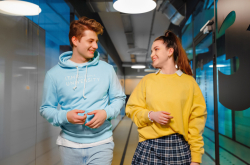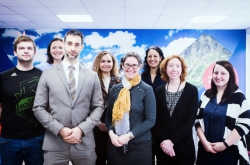Many of the world’s major universities are launching courses on the development of creative skills. What is your course’s place in this global process and how does it align with ITMO University’s general strategy for development?
ITMO University is a progressive and leading research and education center. It’s only logical that a course like ‘Creative Technologies’ was bound to appear at some point. The new set of disciplines aligns with our university’s image as one that seeks to develop creative potential and generate innovative interdisciplinary ideas, one that attracts and trains non-standard thinkers who are quick to react to changes in the world. When we were developing the course, one of our goals was to establish an expansive creative framework and form a team of creative professionals. In our opinion, creativity is one of the biggest requirements for university graduates today, and ITMO University is one of the first Russian higher education institutions to respond to that trend. This program is part of that response.
We analyzed the market and considered the various methods, techniques, and principles used by international universities and integrated the most effective ones with a few domestic inventions, such as the TIPS (the theory of inventive problem solving) and a few acting exercises. As a result, we got a very unique product close to the Russian mentality and focused on an unorthodox solution, but one that’s still relevant abroad.

What’s so unique about the ‘Creative Technologies’ course?
It’s different from others in form and content. Many foreign universities, such as Massachusetts Institute of Technology, Dyson School of Design Engineering, Creativity Stanford University, INSEEC, and others, are focused on one or several related groups of students. At those universities, creative technologies is something reserved for, say, students of multimedia, business, design or social entrepreneurship. ITMO University trains specialists in a wider range of fields, and we took that into account.
We drew up a graph to show the basic goals set by the various Russian and international creative development initiatives, as well as the methods they use. Unlike others, our course is based on a systematic approach, but remains flexible: there’s a general track along which the students move while shedding off the various psychological barriers that hinder their ability to think outside of the box, begin to believe in their creativity and learn how to stimulate it and use it. Splitting them into random groups lets us bring together students of different fields and foster interdisciplinary collaboration. It’s a great experience of individual and collective work, and the skills they gain from it will be useful no matter which career they pick.

What about the methodology?
We had to take into account that our students all have different levels of creative experience, which vary greatly. Another factor is self-esteem, as some just don’t think of themselves as creative. It’s a stereotype that hinders their ability because they either don’t believe in themselves or don’t believe that creativity belongs in exact sciences. But you can’t create new technology, make a discovery or an invention if you only think in clichés. It’s important that the students realize the power of creativity and learn to harness it.
At the same time, they learn about the nature of our mind and intuition, and how to understand and “tune” their mind. We use psychology to educate them on the theories of creativity and acting to make them test these theories in practice. Practical training is given in such a way that everyone is able to do it no matter their subject area, and the online format lets them do it in a comfortable environment.
We also use various novel methods, such as mind-mapping, to visualize information and seek out unorthodox solutions. Another novelty is the use of prototyping as a way of thinking via material. All in all, every method we apply in the course is used to facilitate a variety of solutions and foster the types of intelligence: visual, spatial, logical, mathematical, emotional, and others.

What is the connection between creative technologies and creative thinking?
Creative technologies are the tools used by a creative individual, and they are the levers that help activate the creative aspect of thought.
Innovative economic and social models are in high demand today, and it is helping break down the traditional divide between exact sciences and humanities. The development of science, art, and technology always happens due to new ideas, and from that point of view, a scientist, inventor, and artist are the same.
The course aims to combine imagination and intuition with their practical applications, with its main goal being the creation of a new type of professional. We want students not just to know the most effective methods, but to be ready to take on challenges.

What is the format of the ‘Creative Technologies’ course?
It consists of video lectures, practical online tasks, including tests, and in-person consultations. In addition to video clips, students also have access to texts that expand on each subject and help them prepare for tests. The course is structured such as to introduce the students to a new topic each week and give them the opportunity to consolidate the newfound knowledge through practice.
The final part of the course involves active casework in small teams. This year, the students were given a choice between 85 cases, one for each five-person team, including topics such as “Transformation of urban objects for the improvement of accessibility”, “Interactivity in education as a means of sustainable development”, “Systematization of urban data with consideration of citizen activity levels”, and “Robotization for environmental purposes”. We picked topics that reflected relevant social, environmental, urban, and technological problems and also allowed students to apply knowledge in the various fields studied at ITMO University.

An important element of casework was the need to analyze the social demand for technologies. It’s a key moment that helps bridge the divide between solutions and their implementation in real life. At the end of the course, the curators take part in an open vote to choose the top projects.
Which skills do the students acquire by the end of the course?
The students acquire three kinds of competencies. The first kind is social and cultural ones, which form their worldview and values, their ability to communicate with other cultures and work with large amounts of data. The second kind is soft skills, which help them develop, implement and manage projects, as well as work in interdisciplinary teams. The third kind is professional skills, which affect the way they do research, contribute to the general scientific worldview and evaluate solutions.

Today, nearly six months after the course was launched, what have you learned? How effective was it? What would you like to improve or change about it?
The pilot run was an interesting and useful experience for both us and the students. We learned a lot from their feedback and the way they reacted to the course, and it will definitely help us develop it further as well as to create iterations for Bachelor’s degree and international programs, which we plan to launch in the 2019/2020 academic year.
We had three goals when designing the course: to foster the students’ personal creative qualities through teamwork, to facilitate interdisciplinary cooperation, and to ensure a variety of ideas. All in all, the three goals have been reached. Nevertheless, we know that there is room to grow, especially because a few difficulties became evident later on.

For one, we’d like to make it easier for students to sign up in the system and make the team members “visible” in the open.edu system. We also want to create chatrooms within the teams and find a way to check the test results automatically.
As for methodology, most issues have to do with the nature of online education. This form of learning came to Russia much later than in other countries. It requires a great degree of motivation, self-management, and willpower. A lot here depends on the students themselves.
What results do you expect to see from the course?
We expect the students to use the skills they acquired during the course in their theses, and to take on daring, novel and truly significant topics, which will serve as a great start for their careers and groundwork for their portfolios. Creative experience is highly valuable in research.
Other universities have also shown interest in the course. Its online format, universal nature, and English-language availability help make it widely accessible. We hope to expand the effect of education on the development of creative abilities and therefore create a reputation for ITMO University as not only a “non-classical”, but also a “creative” university.



